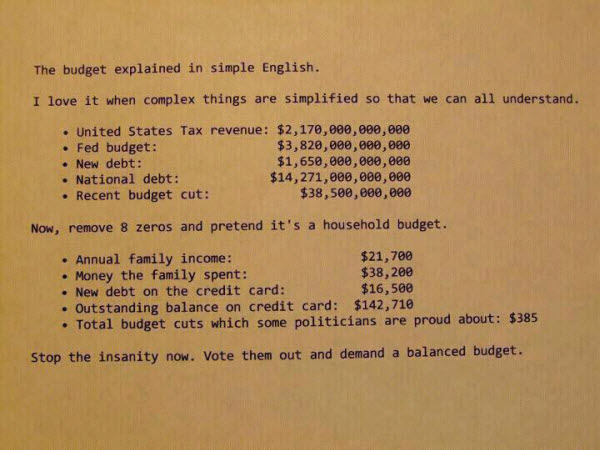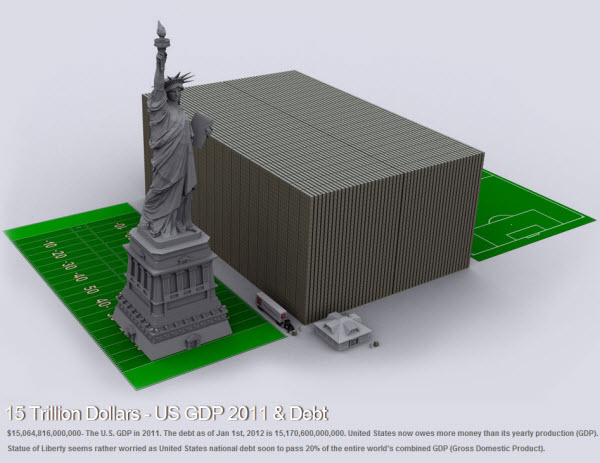Back in the 1960s, Illinois Senator Everett Dirksen famously quipped, "A billion here, a billion there — pretty soon, you're talking real money."
To get a sense of how Trillions currently are discussed in Congress, watch this.
How quaint … Recently, Trillion has become the new billion; especially when we're talking about government debt, government budget, and the budget deficit.
So, let's put a "Trillion" in better context.
What follows are a few creative ways to look at the U.S. government budget and what's happening to our national debt.
1. The U.S. Government Budget Compared to an American Household
This has been making the rounds. I saw several copies on social media sites, and it puts things in a format most of us can understand easily.
I'm not sure of its source, but you can also see a version of it in this video showing CNBC correspondent, Rick Santelli, explaining the government budget and the budget deficit.
2. U.S. Government Debt Illustrated in Pictures
The national debt clock continues ticking.
Here is what the $15 trillion U.S. debt looks like when it is piled up in stacks of $100 bills.
Do you see the the tiny-in-comparison tractor trailer? Squint, and you can see the barely visible human in front of it.
Well, that put things in perspective.
So does this video.
You don't need the national debt clock to get a sense how big the deficit is becoming, or how hard it is to start reducing it meaningfully.
3. Or If You Just Like Simple Math…
The circumference of the earth is 24,738 miles.
If laid $15 trillion one-dollar bills end-to-end, it would be 1,444,000,000 miles long … Enough to circle the earth's equator 58,390.5 times.
If you were to drive around the earth in your car 58,390.5 times at an average speed of 70 mph non-stop, it would take you 2,385 years to finish.
Click here for some other facts about "a trillion" … or here too.
So What Does it All Mean?
These are some big numbers. But as Nicholas Vardy points out, the focus on U.S. debt ignores once crucial factor — the value of the balance sheet or accumulated wealth of the United States. That figure probably stands between $150 trillion and $200 trillion. That amount is 10- to 13-times the size of the current U.S. government debt.
In other words, the U.S. is not going to the poor-house anytime soon. But the trends are sobering, nonetheless.




The craze of debt is being drastic amongst the people and every single person is holding one or another debt. It’s not only for the individuality but the countries are also facing the loads of debt, which is certainly a big bubble bursting issue with hindering mis-happenings. The debt is been increasing day-by-day with more number of mishaps; some definite measures have to be assigned by the connoisseurs so that financial barrels are been managed smartly.
The debt of U.S. is like a milestone with great impact on the citizenship and humanity. This has increased because of carelessness and improper calculation made with the finance or might be looking towards self earning prospects which have drowned the country so much into debt. If looking towards the future prospects things can be work on and measures can be applied to overcome debt.